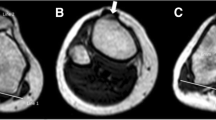Abstract
Purpose
The quadriceps angle (Q-angle) represents the angle between the vector of action of the quadriceps and the patellar tendon. An increased Q-angle has been associated with an increased risk of patellar instability, although there is disagreement on its reliability and validity as it is affected by the position of the limb and contraction of the quadriceps. Tibial tuberosity–trochlear groove distance (TT–TG) is ascertained by axial CT scanning, with an increased value associated with patellar instability. This study aimed to determine whether the Q-angle correlates with the TT–TG distance in patients with patellar instability.
Methods
Q-angles were measured in 34 knees that had previously undergone CT scanning for assessment of patellar instability. Measurements were made with the patient supine, the knee extended and the lower limbs in neutral rotation with the quadriceps relaxed and contracted. TT–TG distance was measured on CT scanning in an identical position.
Results
Of the 34 knees measured, 24 had symptoms of patellar instability, and 10 were normal. A significant negative correlation between relaxed Q-angle and TT–TG in all knees was demonstrated (p = 0.028). In symptomatic knees, contracted Q-angle also demonstrated a significant negative correlation with TT–TG (p = 0.037).
Conclusions
If TT–TG distance is regarded as the gold standard measurement, Q-angle is not a reliable indicator of patellar instability. There is a clear need to develop methods to more fully characterise the knee and factors contributing to patellar instability.
Level of evidence
II.



Similar content being viewed by others
Abbreviations
- ASIS:
-
Anterior superior iliac spine
- CT:
-
Computerised tomography
- MPFL:
-
Medial patellofemoral ligament
- Q-angle:
-
Quadriceps angle
- TT–TG:
-
Tibial tuberosity–trochlear groove
References
Aglietti P, Insall JN, Cerulli G (1983) Patellar pain and incongruence. I: measurements of incongruence. Clin Orthop Relat Res 176:217–224
Ando T, Hirose H, Inoue M, Shino K, Doi T (1993) A new method using computed tomographic scan to measure the rectus femoris-patellar tendon Q-angle comparison with conventional method. Clin Orthop Relat Res 289:213–219
Balcarek P, Ammon J, Frosch S et al (2010) Magnetic resonance imaging characteristics of the medial patellofemoral ligament lesion in acute lateral patellar dislocations considering trochlear dysplasia, patella alta, and tibial tuberosity–trochlear groove distance. Arthroscopy 26(7):926–935
Balcarek P, Jung K, Ammon J et al (2010) Anatomy of lateral patellar instability: trochlear dysplasia and tibial tuberosity–trochlear groove distance is more pronounced in woman who dislocate the patella. Am J Sports Med 38(11):2320–2327
Balcarek P, Jung K, Frosch KH, Stürmer KM (2011) Value of the tibial tuberosity–trochlear groove distance in patellar instability in the young athlete. Am J Sports Med 39(8):1756–1761
Biedert RM, Gruhl C (1997) Axial computed tomography of the patellofemoral joint with and without quadriceps contraction. Arch Orthop Trauma Surg 116(1–2):77–82
Brattström H (1970) Patella alta in non-dislocating knee joints. Acta Orthop Scand 41(5):578–588
Colvin AC, West RV (2008) Patellar instability. J Bone Jt Surg Am 90(12):2751–2762
Dejour H, Walch G, Nove-Josserand L, Guier C (1994) Factors of patellar instability: an anatomic radiographic study. Knee Surg Sports Traumatol Arthrosc 2(1):19–26
France L, Nester C (2001) Effect of error in the identification of anatomical landmarks on the accuracy of Q angle values. Clin Biomech 16(8):710–713
Guerra JP, Arnold MJ, Gajdosik RL (1994) Q angle: effects of isometric quadriceps contraction and body position. J Orthop Sports Phys Ther 19(4):200–204
Huri G, Atay OA, Ergen B, Atesok K, Johnson DL, Doral MN (2011) Development of femoral trochlear groove in growing rabbit after patellar instability. Knee Surg Sports Traumatol Arthrosc. doi:10.1007/s00167-011-1603-0
Kita K, Horibe S, Toritsuka Y et al (2011) Effects of medial patellofemoral ligament reconstruction on patellar tracking. Knee Surg Sports Traumatol Arthrosc. doi:10.1007/s00167-011-1609-7
Nelitz M, Theile M, Dornacher D, Wölfle J, Reichel H, Lippacher S (2011) Analysis of failed surgery for patellar instability in children with open growth plates. Knee Surg Sports Traumatol Arthrosc. doi:10.1007/s00167-011-1599-5
Panni AS, Cerciello S, Maffuli N, Di Cesare M, Servien E, Neyret P (2011) Patellar shape can be a predisposing factor in patellar instability. Knee Surg Sports Traumatol Arthrosc 19(4):663–670
Philippot R, Boyer B, Testa R, Farizon F, Moyen B (2011) The role of the medial ligamentous structures on patellar tracking during knee flexion. Knee Surg Sports Traumatol Arthrosc. doi:10.1007/s00167-011-1598-6
Schoettle PB, Zanetti M, Seifert B, Pfirrmann CW, Fucentese SF, Romero J (2006) The tibial tuberosity–trochlear groove distance; a comparative study between CT and MRI scanning. Knee 13(1):26–31
Shakespeare D, Fick D (2005) Patellar instability—can the TT–TG distance be measured clinically? Knee 12(3):201–204
Smith TO, Hunt NJ, Donell ST (2008) The reliability and validity of the Q-angle: a systematic review. Knee Surg Sports Traumatol Arthrosc 16(12):1068–1079
Smith TO, Davies L, Toms AP, Hing CB, Donell ST (2011) The reliability and validity of radiological assessment for patellar instability. A systematic review and meta-analysis. Skeletal Radiol 40(4):399–414
Stäubli HU, Dürrenmatt U, Porcellini B, Rauschning W (1999) Anatomy and surface geometry of the patellofemoral joint in the axial plane. J Bone Jt Surg Br 81(3):452–458
Wagenaar FC, Koëter S, Anderson PG, Wymenga AB (2007) Conventional radiography cannot replace CT scanning in detecting tibial tubercle lateralisation. Knee 14(1):51–54
Wilson T, Kitsell F (2002) Is the Q-angle absolute or a variable measure? Measurement of the Q-angle over one minute in healthy subjects. Physiotherapy 88(5):296–302
Author information
Authors and Affiliations
Corresponding author
Rights and permissions
About this article
Cite this article
Cooney, A.D., Kazi, Z., Caplan, N. et al. The relationship between quadriceps angle and tibial tuberosity–trochlear groove distance in patients with patellar instability. Knee Surg Sports Traumatol Arthrosc 20, 2399–2404 (2012). https://doi.org/10.1007/s00167-012-1907-8
Received:
Accepted:
Published:
Issue Date:
DOI: https://doi.org/10.1007/s00167-012-1907-8




